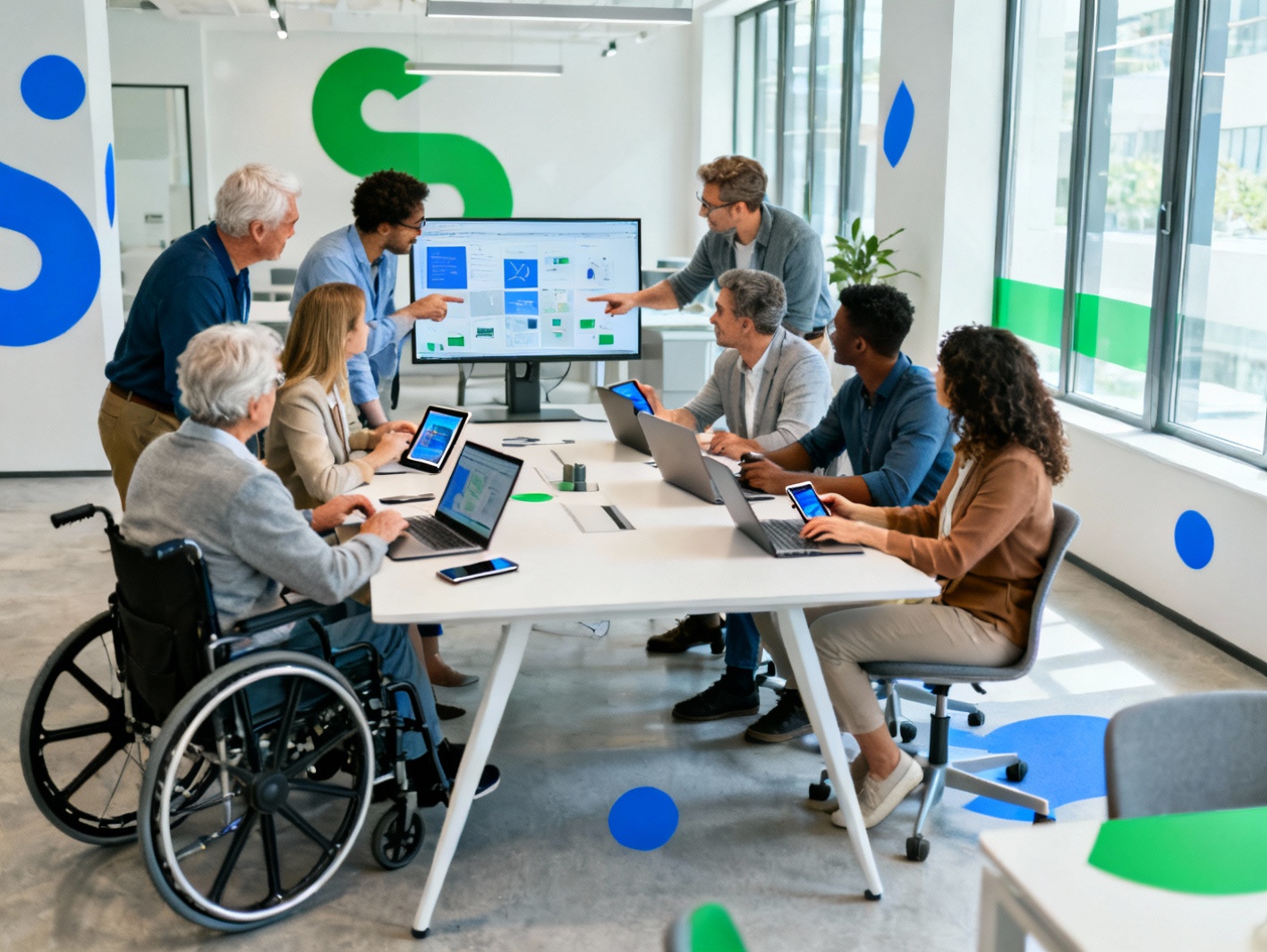Table of Contents
- Introduction
- Introducing ‘Braille Access’: A Game-Changer for Braille Users
- Enhanced Zoom Capabilities in Vision Pro: A Closer Look
- System-Wide Reading Mode: Facilitating Easier Text Consumption
- Integration with Assistive Apps: Expanding Accessibility Horizons
- Apple’s Commitment to Accessibility: A Broader Perspective
- Conclusions
Apple has taken a significant leap forward in making its products more inclusive with the introduction of new accessibility features tailored for users with visual and reading impairments. Among the most notable enhancements is Braille Access, a feature that allows Apple devices like iPhone, iPad, Mac, and Vision Pro to function as full-fledged braille note takers. Combined with system-wide tools such as upgraded zoom options in Vision Pro and a dedicated reading mode, these features aim to provide a more autonomous and enriching user experience. This article explores each of these innovations in depth, examining how they empower users and strengthen Apple’s reputation as a leader in accessible technology.
Introducing ‘Braille Access’: A Game-Changer for Braille Users
Apple’s new Braille Access feature transforms iPhone, iPad, Mac, and Vision Pro devices into portable and powerful braille note takers. This functionality supports both the use of external braille displays via Bluetooth and the built-in Braille Screen Input on touch devices. Users can input braille directly through the screen using screen gestures, or through physical braille devices if preferred. This dual approach allows individuals to select the method that best aligns with their tactile preferences and learning style.
Compatibility is key to the success of Braille Access. Apple has ensured that this feature supports a wide range of braille displays from major manufacturers, making it easy for users to connect their existing hardware. Once connected, users gain real-time output for navigating content, composing notes, browsing the web, and more—all in braille. This seamless integration makes Apple devices a viable and robust alternative to traditional braille note takers, many of which can be prohibitively expensive or limited in functionality.
The native support spans system-level settings and productivity apps like Mail, Notes, Pages, and Safari. Features such as automatic translation between braille and text make communication more fluid, especially when collaborating with sighted peers or using online tools. For students and professionals who rely on braille for literacy, this feature delivers freedom and efficiency unlike many standalone devices.
Crucially, Braille Access also taps into iCloud synchronization, ensuring that braille-written notes and documents are backed up and accessible across all Apple devices. From the classroom to the workplace, these enhancements offer users a unified ecosystem that prioritizes accessibility, helping bridge gaps in education and daily communication.
Enhanced Zoom Capabilities in Vision Pro: A Closer Look
Apple’s Vision Pro introduces sophisticated zoom capabilities specifically designed to support users with low vision. By utilizing the device’s advanced camera system, Vision Pro can now magnify the environment in a highly intuitive and responsive way. This enhancement builds on years of Apple’s commitment to assistive features like Zoom in macOS and iOS, raising it to a spatial computing level.
The zoom feature works by letting users digitally enlarge areas of their real-world surroundings while still interacting with apps and digital overlays. This functionality is particularly helpful in crowded or unfamiliar environments, where reading signs or interpreting facial expressions might otherwise be difficult. With visual information projected directly in front of the user’s eyes and enhanced in real time, the Vision Pro opens up new opportunities for independence.
The system makes use of both hardware and software optimizations. High-resolution image capture ensures that the magnified view remains sharp and stable, even when the user or objects in the environment are in motion. Apple also includes customizable settings that allow users to adjust contrast, filters, and zoom levels according to their specific visual needs.
One standout aspect is the ability to freeze the zoomed image, giving users time to read lengthy text or analyze visual information without pressure. Whether it’s reading a restaurant menu from afar or identifying a bus route number, this feature offers crucial support for day-to-day tasks. Coupled with other accessibility options like VoiceOver and audio descriptions, the new zoom capabilities make spatial computing with Vision Pro accessible to a wider audience than ever before.
As Vision Pro blends the digital and physical worlds, its integrated zoom tools give visually impaired users more control over how they interact with the environment—making it easier to navigate, participate in conversations, and engage with spatial applications in a meaningful way.
System-Wide Reading Mode: Facilitating Easier Text Consumption
Apple’s introduction of a system-wide reading mode has the potential to dramatically improve the experience for users with dyslexia, low vision, or other reading challenges. This new mode reconfigures text display throughout the system and within apps to make it more readable and engaging, supporting smoother interpretation and retention.
The reading mode offers adjustable spacing between lines, letters, and words, allowing users to minimize visual crowding and reduce the cognitive load. Users can also enable high-contrast text, simplify complex fonts into more readable formats, and activate text-to-speech features to follow along with content audibly. These adjustments are critical for those with dyslexia, who often benefit from a streamlined layout where fewer visual elements compete for attention.
Apple has also embedded options for background color customization, letting users switch to color combinations that reduce glare and enhance visual clarity. Light sensitivity and contrast issues, common for those with low vision, are addressed with darker themes and softer hues that reduce eye strain. By implementing these changes at the system level, Apple ensures consistent accessibility whether the user is reading emails, browsing Safari, or taking notes.
Another vital aspect is dynamic text resizing. This enables users to scale font sizes without losing interface usability, making it easier for them to absorb content without requiring magnification devices. The inclusion of read-aloud capabilities, synchronized with visual highlighting, allows users to follow text and speech simultaneously—providing valuable reinforcement for comprehension.
This feature isn’t limited to users with specific diagnoses. Anyone who experiences fatigue, distraction, or dislikes conventional reading formats can benefit. In essence, Apple’s reading mode integrates inclusive design directly into the everyday user experience, reflecting a broader vision where access and comprehension are not barriers, but foundational design principles.
Integration with Assistive Apps: Expanding Accessibility Horizons
With the Vision Pro, Apple has made a progressive move by allowing certain approved apps like Be My Eyes to access the device’s main camera system. This unprecedented integration enables real-time remote assistance, offering transformative benefits for people who are blind or have low vision. By combining wearable technology with live video streaming, users can receive direct help with tasks that require visual context.
Be My Eyes connects users with a global network of volunteers or trained professionals who can see what the Vision Pro camera sees and provide spoken guidance. Whether it’s reading expiration dates on groceries, identifying unfamiliar locations, or choosing clothing colors, this live feedback feature is a game-changer for accessibility in everyday scenarios.
The integration is more seamless and native compared to typical smartphone use. Since Vision Pro is hands-free, users can move through their environment freely while interacting with assistants. The stereoscopic cameras add depth perception, giving helpers a clearer understanding of context and orientation. This expands the quality of assistance possible, bridging nuanced visual gaps that might go unaddressed with phone-based video calls.
Moreover, Apple ensures that privacy and security are woven into this functionality. App access to the camera is tightly controlled, requiring user consent and system-level permissions to avoid misuse. Visual data is transmitted only while the app is active, maintaining the levels of discretion necessary for sensitive visual information.
This capability opens new pathways for people who need on-the-go help, from navigating transit stations to reading documents in real time. The combined power of high-definition imaging, mobility, and cloud-based human support illustrates how technological ecosystems like Vision Pro can significantly uplift accessibility. As developers begin to explore what’s possible with these capabilities, it’s likely that more purpose-built services will emerge—pushing Vision Pro beyond mere consumer utility into the realm of daily life-enhancing technology.
Apple’s Commitment to Accessibility: A Broader Perspective
Apple’s consistent rollouts of accessible technology reflect a deep-rooted philosophy: design for everyone. From the earliest days of macOS to today’s innovations like Braille Access and visual enhancements in Vision Pro, Apple has proven that accessibility isn’t an afterthought—it’s a foundation of product development. Each new generation of devices builds upon years of user feedback, collaboration with advocacy organizations, and internal research.
Unlike some tech rivals who often outsource accessibility tools to third-party applications, Apple integrates these features directly into its operating systems. This strategy guarantees universal availability, consistent performance, and ongoing updates that keep pace with evolving needs. Recent announcements continue this legacy, introducing features that not only address disability-specific barriers but also improve usability for a wider audience, such as dyslexia aids and customizable visual settings.
Apple’s dedication stands out especially when compared to companies like Meta. While Meta explores immersive AI and virtual reality, it has yet to match the comprehensive and built-in nature of Apple’s accessibility ecosystem. With features like VoiceOver, AssistiveTouch, and Dynamic Type having existed for years, Apple has shown continuity and reliability in its approach.
The addition of apps like Be My Eyes to Vision Pro also reflects Apple’s ability to collaborate meaningfully with the nonprofit and disability communities. These partnerships have shaped tools that go beyond compliance and begin to reshape what’s possible for users who were previously underserved. The expanding role of spatial computing offers new dimensions for accessibility, and Apple appears well-positioned to lead that evolution.
In the expanding assistive tech market, Apple’s choices send a clear message: accessible technology is not a niche; it’s a necessity. By offering deeply integrated features that empower millions of users worldwide, Apple is not only enhancing digital inclusion but also raising the bar for the entire tech industry.
Conclusions
Apple’s latest array of accessibility tools—from the all-encompassing Braille Access to Vision Pro’s enhanced zoom and reading support—cements its role as a pioneer in inclusive technology. These features are not just functional add-ons; they fundamentally reshape how people with disabilities interact with devices, information, and environments. By building these tools into the hardware and software from the ground up, Apple ensures equitable access for all users, regardless of ability. As competitors seek to catch up in the assistive tech space, Apple’s steady commitment and thoughtful innovation remain benchmarks of leadership and progress.










